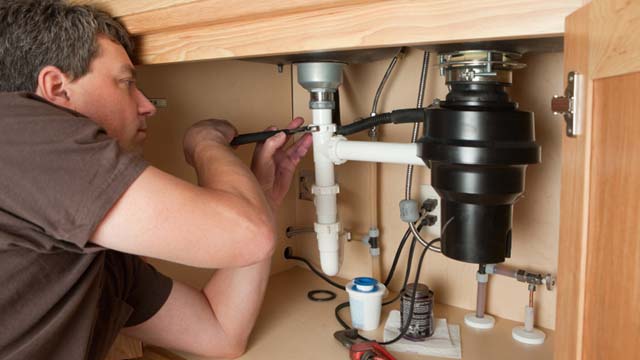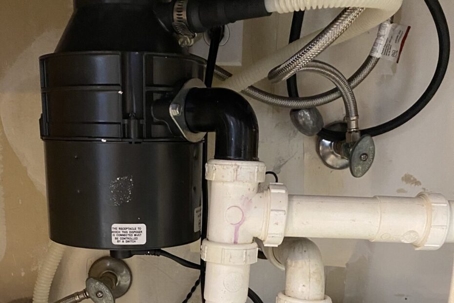Step-by-Step Techniques for Repairing a Leaky Garbage Disposal
Step-by-Step Techniques for Repairing a Leaky Garbage Disposal
Blog Article
We've unearthed this post relating to Garbage Disposal Leaking From Bottom directly below on the internet and decided it made sense to write about it with you here.

Waste disposal unit are crucial kitchen area devices that assist in throwing away food waste efficiently. Nonetheless, a leaking garbage disposal can be an irritating and messy trouble to deal with. Luckily, several leaks can be repaired easily with a few basic actions. In this article, we will talk about exactly how to take care of a dripping waste disposal unit efficiently.
Introduction
Garbage disposals are installed under kitchen sinks and are developed to shred food waste into smaller pieces, permitting it to travel through the pipes system conveniently. While these devices are generally reliable, leakages can take place gradually as a result of damage, loose links, or damage to the device.
Step-by-Step Guide to Dealing With a Dripping Garbage Disposal
Shut off the Power
Before attempting any repair services, make certain that the power to the waste disposal unit unit is turned off to avoid the threat of electric shock.
Situate the Leakage
Recognize the specific place of the leakage and identify the reason
Tighten Connections
Use a wrench to tighten any kind of loose links between the disposal unit and the pipes system.
Replace Seals or Gaskets
If the leak results from used seals or gaskets, remove the old elements and change them with brand-new ones.
Patching Cracks or Holes
For fractures or openings in the disposal device, use epoxy or a suitable patching material to seal the damaged area.
Determining the Resource of the Leak
Before trying to fix a leaking garbage disposal, it is necessary to determine the source of the leak. This can usually be done with visual inspection or by conducting straightforward tests.
Visual Inspection
Evaluate the waste disposal unit system thoroughly for any type of signs of water leakage. Pay attention to areas around seals, gaskets, and link points.
Testing for Leaks
One means to evaluate for leakages is by running water through the disposal device and checking for any type of noticeable signs of leak.
Common Root Causes Of Leakages in Trash Disposals
Worn Seals and Gaskets
Seals and gaskets play a crucial function in stopping water from dripping out of the garbage disposal. In time, these elements can wear away, leading to leaks around the disposal unit.
Loose Connections
The links in between the garbage disposal and the plumbing system can end up being loose over time, triggering water to leakage out throughout operation.
Fractures or Openings in the Disposal Unit
Physical damages to the garbage disposal, such as splits or holes in the real estate, can likewise result in leaks.
Tools and Materials Needed for Repairing a Leaking Waste Disposal Unit
Prior to beginning the repair work process, gather the essential devices and products, consisting of a screwdriver, adjustable wrench, plumbing technician's putty, substitute seals or gaskets, and epoxy or patching product for repairing fractures or holes.
Testing the Garbage Disposal After Repair Service
When the repair is full, evaluate the garbage disposal by running water with it to guarantee that the leakage has been dealt with.
Preventive Upkeep Tips to Prevent Future Leakages
To prevent future leakages, it is necessary to do regular maintenance on your waste disposal unit. This includes keeping it tidy, preventing placing non-food things or hard items down the disposal, and occasionally looking for leaks or other problems.
Final thought
Finally, fixing a leaking waste disposal unit is a reasonably straightforward process that can be completed with basic tools and products. By adhering to the actions described in this write-up and practicing precautionary upkeep, you can maintain your garbage disposal in good working condition and prevent pricey repairs in the future.
What to Do About a Leaking Garbage Disposal
A leaking garbage disposal often goes unnoticed until you confront a sopping cabinet, a foul-smelling puddle, or an audible drip-drip-drip from the unit. The fix can be frustrating, too, because the leak can stem from a number of components in the system. Fortunately, with a little sleuthing, you can zero in on the leak and—depending on the exact location—stop the icky oozing and repair the component that caused it. Worst case scenario, if it turns out that the garbage disposal must be replaced, installing a new one is a reasonable do-it-yourself task for those with basic plumbing skills. Read on to keep the cash you’d otherwise hand over to a pro.
Prepare to find the leak
Prior to testing the garbage disposal for leaks, unplug it at the wall outlet and turn off the power from the breaker box to prevent electrical shock. Then insert a watertight sink stopper into your sink drain and wipe the unit dry with a clean cloth. In any handy container, mix a few drops of food coloring into a few cups of water, and pour the dyed water onto the sink stopper to help you locate the leak.
Investigate the source
the top, where the disposal meets the sink drain the side, where the dishwasher hose or main drain pipe connects to the disposal or the bottom of the unit Inspect each of these locations while gliding a light-colored rag over the unit; the dyed water will readily show on the rag and reveal the location of the leak. If a leak isn’t immediately apparent, remove the sink stopper and pour a few more cups of dyed water down the sink drain, then check for leaks again. Leaks near the top of the unit are more likely to show themselves while the sink is plugged, while side and bottom leaks are more noticeable while the sink is unplugged.
The metal sink flange that sits directly inside the sink drain is typically sealed around the top with plumber’s putty (a clay-like sealant) and then secured from under the sink with bolts. If the plumber’s putty deteriorates, or the bolts loosen, the flange can no longer form a watertight seal between the sink drain and the disposal—which could cause a leak at the top of the unit.
To reseal the leaky flange, you must first detach the garbage disposal. Start by loosening the screws securing the main drain pipe to the disposal, then loosen the screws in the metal clamp securing the dishwasher hose to the disposal and detach the drain pipe and dishwasher hose from the disposal. Loosen the screws in the mounting ring that connects the disposal to the metal mounting assembly beneath the sink, then pull down the disposal and carefully set it on a clean, dry surface. Loosen the bolts in the mounting assembly with a wrench, then pull down the mounting assembly and set it near the disposal.

As a passionate reader about How to fix a pretty consistent leak from my garbage disposal, I assumed sharing that article post was smart. Do you know somebody who is sincerely interested in the niche? Be sure share it. Thanks so much for going through it.
Book Services Report this page